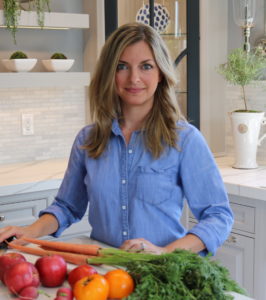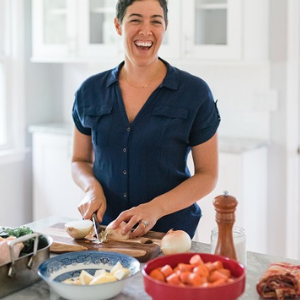[This article was recently published by Natural Nutmeg Magazine on their digital magazine.]
This article is a conversation between two moms, Sarah Ricci & Ayelet Connell:
Sarah Ricci is a full-time working mom that has a passion for home cooking. Sarah spends hours on the weekend teaching her children about food as they explore, test, and create recipes as a family. She chronicles her family’s cooking adventures at www.CookingWithRiccis.com. Ayelet Connell PhD is a Paleo & Gluten-free chef and teaches group and individual cooking classes, showing people how to create simple and delicious gluten-free and paleo meals. Ayelet also loves to cook and especially bake with her children. She writes a food blog at www.SimplyPaleo.com.
The authors of this article wish to say thank you to PlanetBox for their very generous donation of a PlanetBox lunchbox. The PlanetBox “Launch” lunchbox was used for the school lunch box photos in this article. For more information about PlanetBox lunchboxes, you can visit this link: https://www.planetbox.com/
Ayelet: I know how important cooking with your family is and involving them in the creative process of putting together a healthy meal. Why is this so important to you?
Sarah: I have always been curious about food, where food comes from, the process it goes through to get to our supermarkets, and the transformation it takes to end up on our plates. It just amazes me! At a young age my parents exposed me to cooking, and I remember spending summers in the kitchen with my grandmother and mother making meals. In our house we ate fruits, vegetables, whole-grains, and lean proteins. Rarely did we ever eat processed foods, and desserts, which were for parties. As I grew up and moved away from home to college, I was quickly exposed to a new culinary world. I discovered food has so many more layers than what I was exposed to in my childhood. Now with a family of my own, it is important to me to engage my kids in the process of cooking. For us, creating a meal is like an art project where we explore flavors and layers of texture as a group. I find that if my children understand where food comes from and how to prepare each ingredient, they are more willing to eat the foods we serve at our kitchen table. One of the tasks we share with our children weekly is also one of the simplest. When we get home from the market, we let our kids wash all the fresh fruits and vegetables before storing them away. They love using the spray bottle to squirt the produce, scrubbing under the faucet, and using towels to dry everything. Teaching them to work together as a team has its challenges, but it is so rewarding watching them get excited about unpacking the groceries. In the summer, we also grow a small garden in our backyard. We plant together in the spring and pick vegetables like beans, tomatoes, squash, peppers, and herbs all summer. The kids get excited at dinner to eat squash because they have spent weeks watching it flower and grow.
Sarah: Healthy eating is a big part of your life as well. Tell me a little bit about what healthy eating means to you…
Ayelet: I came from a more medical background. I am a licensed Physical Therapist and I used to run a wellness center for many years that largely focused on nutritional wellness as well as coaching people on how to live naturally. Teaching people how to create a healthy kitchen in their home has always been important to me, and cooking & baking naturally has been my ultimate passion! My clients over the years have often complained about the challenge of navigating all the varied information out there about what constitutes a healthy diet. I have found time and time again for my family as well as our community that if people suffer from any type of illness or pain, the most helpful change is eliminating foods that contribute to inflammation, essentially, inflammatory foods. Inflammatory foods include gluten (a protein found in wheat, rye, barley, and often oats), refined sugar, and processed foods. For many people, this is enough of a change in diet to see a dramatic improvement in how they feel, but for others, a grand gesture is required to feel better. The grand gesture is often in the form of the Paleo lifestyle which comprises a diet filled with clean natural meat, diverse and ample vegetables and fruit, and nuts and seeds, as well as healthy fats such as extra virgin olive oil, coconut, and avocados. In the Paleo diet, we avoid grain entirely as well as beans. Fortunately, there are wonderful substitutes that can be used to create delicious baked treats that are also non-inflammatory. In my own family, I adopt the Paleo lifestyle for myself because it helps me feel well. For my kiddos, they are gluten-free and we limit refined sugar and processed foods. In the past when they have had some health challenges, we have embraced the Paleo diet more strongly for them, whereas at other times, we just limit the basic inflammatory foods.
Ayelet: As moms, we both recognize the daily challenges of figuring out school lunches. How do you navigate this routine that can often feel like a chore?
Sarah: Eating healthy takes time, but each week I try and overlap ingredients in weeknight dinners and school lunches to cut down on prep time for both meals. The best way to figure this out is by making a meal plan and a shopping list. As a family we carve out time each Sunday to prepare for the week ahead. Taking an ingredient like chicken and infusing it with several variations of flavor keeps my family exposed to different cultures and flavors of food throughout the week.
Sarah: What about you, Ayelet? What strategies work well for you and your family when planning and packing school lunches?
Ayelet: For our family, advanced planning is also essential! My husband and I will typically create a weekly (5-day) lunch schedule with the kids. The categories that need to be met are protein, vegetable, and fruit. I find that creating this grid in advance is fun for the kids and also helps my husband and I not feel stressed during the week since the food schedule is already set!
Click here to download a WEEKLY SCHOOL LUNCH PLAN grid!
School Lunchbox Examples
School lunch is a 5-days-a-week event that every parent has to manage, and sometimes it can feel like a challenge to come up with fresh ideas. A helpful strategy is to include your children in the process of choosing and creating lunch. Children love to spend time with their parents. Having them wash the produce is an easy way to involve them. A simple way to start the process is to have them choose a protein, vegetable, and fruit. Typical school lunches often include foods that are inflammatory and can cause our children to be sluggish in the afternoon. A great way to avoid this is to create lunches that are gluten-free and free of refined sugar. Here are some fantastic “culturally-themed” lunch box menus with recipes included!
American Theme Lunchbox Menu:
- Gluten-free Chicken fingers
- Honey mustard dipping sauce
- Cucumber and carrot sticks
- Sliced apples
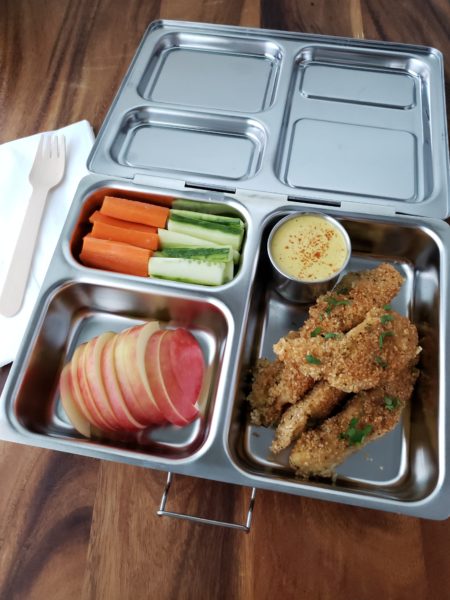 Chicken Fingers Recipe: Cut chicken breast into strips, season with sea salt and pepper, dip chicken strips in beaten egg, then toss in seasoned gluten-free panko, then bake on parchment paper lined baking sheet at 350 degrees for 20 minutes or fry in avocado oil until cooked through.
Chicken Fingers Recipe: Cut chicken breast into strips, season with sea salt and pepper, dip chicken strips in beaten egg, then toss in seasoned gluten-free panko, then bake on parchment paper lined baking sheet at 350 degrees for 20 minutes or fry in avocado oil until cooked through.
Honey Mustard Dipping Sauce Recipe: Mix together ¼ cup honey, ¼ cup mayo, ¼ cup Dijon mustard, 1 tbsp white vinegar, ¼ tsp cayenne (optional).
Grocery List:
- Chicken breast (boneless and skinless)
- Sea salt and pepper
- Gluten-free bread crumbs/panko (seasoned)
- Avocado oil
- Honey
- Mayonnaise
- Dijon mustard
- White vinegar
- Cayenne (optional)
- Cucumber
- Carrot
- Apple
Asian Theme Lunchbox Menu:
- Gluten-free teriyaki chicken with sesame seeds (use store-bought gluten-free teriyaki sauce or make homemade)
- Vegetable sushi roll with fermented cabbage, carrot, and cucumber
- Pickled ginger
- Cucumber slices
- Clementine or mandarin orange slices
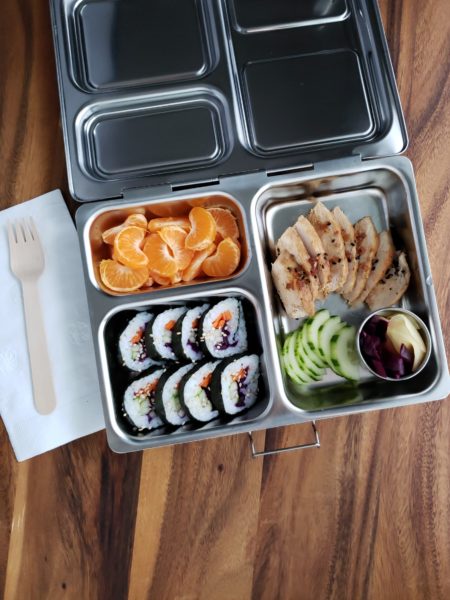 Teriyaki Chicken Recipe: Create homemade teriyaki sauce by whisking together 2 tbsp arrowroot, ¼ cup water, ¼ cup gluten-free soy sauce (or Braggs Aminos), ¼ cup honey, ½ tsp fresh grated ginger. Coat chicken in marinade and bake at 425 degrees Fahrenheit covered with foil until cooked through (about 20 minutes, with internal temperature of 165). Let chicken rest for 15 minutes and then slice and drizzle teriyaki sauce and sprinkle sesame seeds on top.
Teriyaki Chicken Recipe: Create homemade teriyaki sauce by whisking together 2 tbsp arrowroot, ¼ cup water, ¼ cup gluten-free soy sauce (or Braggs Aminos), ¼ cup honey, ½ tsp fresh grated ginger. Coat chicken in marinade and bake at 425 degrees Fahrenheit covered with foil until cooked through (about 20 minutes, with internal temperature of 165). Let chicken rest for 15 minutes and then slice and drizzle teriyaki sauce and sprinkle sesame seeds on top.
Fermented Cabbage Recipe: Slice red cabbage into small slivers, place in large bowl and sprinkle with 2 tsp sea salt, and then massage cabbage slices with salt for 15-20 minutes until softer and wet. Add softened wet cabbage slices into large Mason jar and push down into jar to let liquid rise over cabbage. Let sit in jar at room temperature for 1-2 weeks to ferment. Open jar daily to let out gas and push cabbage below liquid line. (Note: fermented cabbage offers healthy probiotics to support gut health!)
Grocery List:
- Chicken breast (boneless and skinless)
- Sesame seeds
- Gluten-free soy sauce
- Arrowroot
- Honey
- Fresh ginger
- Red cabbage
- Cucumber
- Carrot
- Pickled ginger
- Clementine or mandarin oranges
- Sushi rice
- Sushi wrappers
Mediterranean Theme Lunch Box Menu:
- Sundried tomato pesto chicken breast
- Red beet humus
- Stuffed olives
- Gluten-free crackers
- Chopped cantaloupe and blackberries
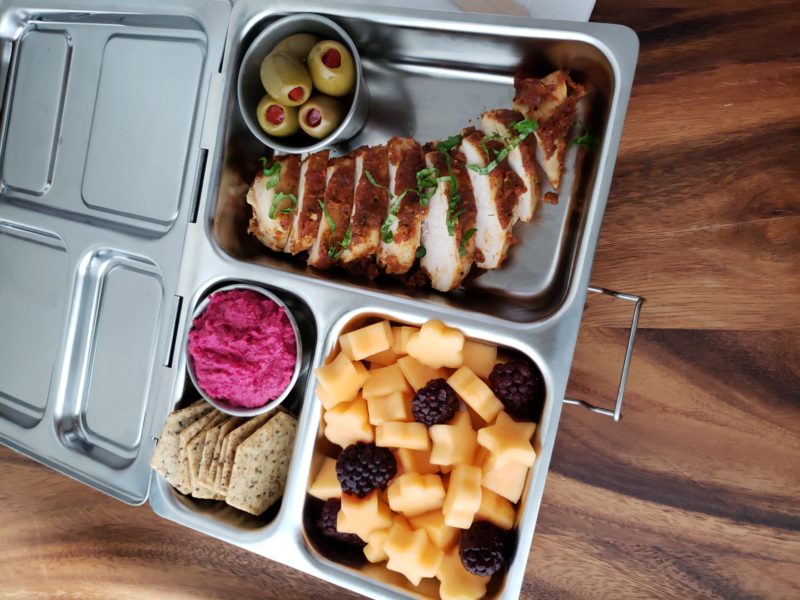 Sundried Tomato Pesto Recipe: In food processor, add 1 cup sundried tomatoes, 3 cloves garlic, 1 cup packed basil leaves, ¼ cup pine nuts, 1/3 cup parmesan cheese (optional), 1 pinch sea salt/pepper/crushed red pepper flakes. Pulse until grainy combined texture. Switch from ‘pulse’ to ‘on’ while you slowly drizzle in 1/3 cup extra virgin olive oil.
Sundried Tomato Pesto Recipe: In food processor, add 1 cup sundried tomatoes, 3 cloves garlic, 1 cup packed basil leaves, ¼ cup pine nuts, 1/3 cup parmesan cheese (optional), 1 pinch sea salt/pepper/crushed red pepper flakes. Pulse until grainy combined texture. Switch from ‘pulse’ to ‘on’ while you slowly drizzle in 1/3 cup extra virgin olive oil.
Red Beet Humus Recipe: In food processor, add 1 medium roasted beet (peeled), 1 can chickpeas (drained), zest and juice of lemon, 2 cloves garlic, 2 tbsp tahini, ¼ cup extra virgin olive oil, and salt and pepper to taste. Mix well until desired consistency.
Grocery List:
- Chicken breast (boneless and skinless)
- Sundried tomatoes
- Basil
- Garlic
- Pine nuts
- Parmesan cheese (optional)
- Extra virgin olive oil
- Crushed red pepper flakes
- Gluten-free crackers
- Stuffed olives
- Cantaloupe
- Blackberries
- Red beet
- Chickpeas
- Tahini
- Lemon
Mexican Theme Lunch Box Menu:
- Cubed chicken breast (seasoned with salt and pepper)
- Guacamole or mashed avocado
- Corn tortillas
- Sliced bell peppers
- Mango
- Black bean corn salsa
 Black Bean Corn Salsa Recipe: Mix together 1 can black beans (drained), 1 cup frozen corn, ½ red onion (diced), ¼ cup minced cilantro, juice of 1 lime, salt and pepper to taste.
Black Bean Corn Salsa Recipe: Mix together 1 can black beans (drained), 1 cup frozen corn, ½ red onion (diced), ¼ cup minced cilantro, juice of 1 lime, salt and pepper to taste.
Guacamole Recipe: Mash 1 ripe avocado and mix with ½ tsp sea salt, juice of 1 lime, 1 tbs minced cilantro, 2 tbsp chopped tomato, 2 tbsp onion (chopped). (Tip: Coat top of guacamole or mashed avocado container with thin layer of olive oil or avocado oil to prevent oxidation and graying.)
Grocery List:
- Chicken breast (boneless and skinless)
- Avocado
- Tomato
- Red onion
- Cilantro
- Lime
- Corn tortilla
- Mango
- Bell pepper
- Frozen corn
- Can of black beans
